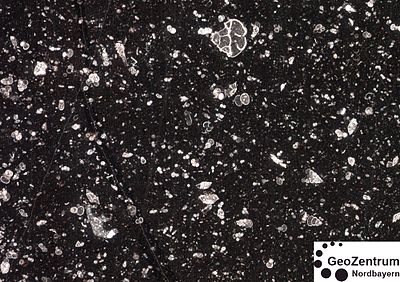Dunham classification
In geology, the Dunham classification is a classification of limestones based on their deposition processes. It was first published by Robert Dunham in 1962, subsequently modified by Ashton F. Embry and JE Klovan in 1971, and revised by Wright in 1992.
Dunham classification
The Dunham classification sorts according to the following criteria:
- Does the lime have an organic basic structure? If yes, then it is Boundstone , if no:
- What type is the matrix ? If it is sparse and if the structure is component-supported, then it is grainstone . Is the structure not predominantly sparse:
- Is the structure component-supported? If so, it is Packstone . Is the structure matrix-supported:
- How large is the proportion of components? If the proportion is greater than 10%, it is Wackestone , otherwise Mudstone .
- Is the structure component-supported? If so, it is Packstone . Is the structure matrix-supported:
- What type is the matrix ? If it is sparse and if the structure is component-supported, then it is grainstone . Is the structure not predominantly sparse:
The classification can be summarized as follows in a table:
| Fine carbonate matrix | Sparitic cement | Organically bound | |||
| Without sparit | With Sparit share | ||||
| Matrix-based | Component-based | ||||
| Less than 10% component content | More than 10% components | ||||
| Mudstone | Wackestone | Packstone | Packstone | Grainstone | Boundstone |
Modification according to Embry and Klovan
The modification according to Embry and Klovan changes the original classification in two places:
- The limes with an organic basic structure are subdivided again according to the type of basic structure and their effect. One differentiates in
- Bafflestone , in which the organisms act as sediment traps .
- Bindstone , in which the organisms act as a sediment binder . Examples of this would be algae mats or incrustation.
- Framestone in which the organisms are scaffolders. An example of this would be reef corals.
- Limes without an organic basic structure are also differentiated according to the size of the components. It is divided into
- Rocks with more than 10% components with a diameter greater than 2 mm ( rudite and larger). These rocks are further divided into Floatstone (matrix-supported, micritic matrix) and Rudstone (component-supported, sparitic matrix).
- Less than 10% components with a diameter greater than 2 mm. The naming of the original Dunham classification applies here.
According to the modified Dunham classification according to Embry and Klovan can be represented as follows:
| (Allochthonous limes) Original components not organogenically bound during the aging process | (indigenous limestones) original components organogenically bound during deposition | |||||||
| Less than 10% components larger than 2 mm | More than 10% components larger than 2 mm | Boundstone (biolithite) | ||||||
| With micrite (smaller than 0.03 mm) | Without micrit | Matrix based | Component-based | Organisms as sediment catchers | Organisms as sediment binders | Organisms as framework pictures | ||
| Mud structure | Component-based | |||||||
| Less than 10% components | More than 10% components | |||||||
| Mudstone | Wackestone | Packstone | Grainstone | Floatstone | Rudstone | Bafflestone | Bindstone | Framestone |
Revised after Wright
The revision according to Wright supplements the modification according to Embry and Klovan with a classification according to the degree of diagenesis. The presence of stylolite is central here . Furthermore, the mudstone from the above classifications is referred to as Calcimudstone . Similarly, the Bindstone is called Bound Stone called. This serves to differentiate more precisely the terms of the Dunham classification from the more commonly used rock names. The revised version can be summarized in the following table:
| composition | Biologically | Diagenetic | ||||||||
| Mixed supported (by silt and clay components) | Component-based | In situ organisms | not obliterative | obliterative | ||||||
| Less than 10% components | More than 10% components | With matrix | Without a matrix | Rigid organisms predominate | Encrusting or binding organisms predominate | Organisms serve as a baffle | Main components cemented | Many grain contacts are microstylolites | Most of the grain contacts are microstylolites | Crystals larger than 10 micrometers |
| Calcimudstone | Wackestone | Packstone | Grainstone | Framestone | Boundstone | Bafflestone | Cementstone | Condensed Grainstone | Fitted grainstone | Sparstone |
| Components larger than 2 mm | Crystals smaller than 10 micrometers | |||||||||
| Floatstone | Rudstone | Microsparstone | ||||||||
Examples
A framestone according to the modified Dunham classification. Scaffolding agents are sponges and crinoids . Image width 36 mm.
Individual evidence
- ↑ a b Martin Okrusch Siegfried Matthes : Mineralogie . An introduction to special mineralogy, petrology and geology. 9th edition. Springer-Verlag, Berlin Heidelberg 2014, ISBN 978-3-642-34659-0 , p. 400 , doi : 10.1007 / 978-3-642-34660-6 .
- ↑ a b c Wolfgang Schlager: Carbonate Sedimentology And Sequence Stratigraphy . 2005, ISBN 1-56576-116-2 , pp. 35 .
- ↑ a b Erik Flügel: Microfacies of Carbonate Rocks . Analysis, Interpretation and Application. Springer-Verlag, Berlin / Heidelberg 2004, ISBN 3-540-22016-X , p. 348-349 .









